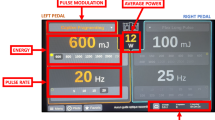Abstract
We reviewed our 6 years of experience with endoscopic holmium: yttrium aluminum garnet (YAG) laser lithotripsy for treatment of urinary stones in different locations in 111 children. A retrospective review was performed on endoscopic holmium: YAG laser lithotripsy procedures performed to treat stones in children between March 2006 and March 2012. In total, 120 laser lithotripsy procedures were performed to treat 131 stones in 111 children (80 males and 31 females; age range, 11 months to 16 years; median age, 6 years). Stones were located in the kidney in 48 cases (36.7 %), ureter in 52 (39.7 %), bladder in 21 (16.0 %), and urethra in 10 (7.6 %). Stone size ranged from 4 to 30 mm (mean, 12.8 mm), and anesthesia duration was 10–170 min (mean, 56 min). Forty-four ureters required balloon dilation, and 61 double J stents were inserted. Follow-up ranged from 3 to 75 months (mean, 35 months). Complete stone clearance was achieved at the end of the procedure in 102 (91.9 %) patients (age < 7 years, 93.3 % vs. age ≥ 7 years, 90.2 %; p > 0.05). The success rate was 81.3 % for kidney stones (<10 mm, 90.9 % vs. ≥ 10 mm, 78.4 %; p > 0.05) and 100 % for the ureter, bladder, and urethral stones. Overall success rate with extracorporeal shockwave lithotripsy was 100 %. No major complications were encountered during or after the procedures. These results confirm the effectiveness and safety of holmium laser lithotripsy for treating all urinary stone locations in children of all ages.
Similar content being viewed by others
References
Curhan GC, Rimm EB, Willett WC, Stampfer MJ (1994) Regional variation in nephrolithiasis incidence and prevalence among United States men. J Urol 151:838–841
Iguchi M, Umekawa T, Katoh Y, Kohri K, Kurita T (1996) Prevalence of urolithiasis in Kaizuka city, Japan-an epidemiologic study of urinary stones. Int J Urol 3:175–179
Tefekli A, Tok A, Altunrende F, Barut M, Berberoglu Y, Muslumanoglu AY (2005) Life style and nutritional habits in cases with urinary stone disease. Turk Uroloji Dergisi 31:113–118
Akinci M, Esen T, Tellaloglu S (1991) Urinary stone disease in Turkey: an updated epidemiological study. Eur Urol 20:200–203
Tan AH, Al-Omar M, Denstedt JD, Razvi H (2005) Ureteroscopy for pediatric urolithiasis: an evolving first-line therapy. Urology 65:153–156
Remzi D, Cakmak F, Erkan I (1980) A study on the urolithiasis incidence in Turkish school-age children. J Urol 123:608
Tellaloglu S, Ander H (1984) Stones in children. Turk J Pediatr 26:51–60
Unsal A, Resorlu B (2011) Retrograde intrarenal surgery in infants and preschool-age children. J Pediatr Surg 46:2195–2199
Atar M, Bodakci MN, Sancaktutar AA, Penbegul N, Soylemez H, Bozkurt Y, Hatipoglu NK, Cakmakci S (2012) Comparison of pneumatic and laser lithotripsy in the treatment of pediatric ureteral stones. J Pediatr Urol. doi:10.1016/j.jpurol.2012.03.004
Dogan HS, Tekgul S, Akdogan B, Keskin MS, Sahin A (2004) Use of the holmium: YAG laser for ureterolithotripsy in children. BJU Int 94:131–133
El-Assmy A, Hafez AT, Eraky I, El-Nahas AR, El-Kappany HA (2006) Safety and outcome of rigid ureteroscopy for management of ureteral calculi in children. J Endourol 20:252–255
Minevich E, Sheldon CA (2006) The role of ureteroscopy in pediatric urology. Curr Opin Urol 16:295–298
Sofer M, Binyamini J, Ekstein PM, Bar-Yosef Y, Chen J, Matzkin H, Ben-Chaim J (2007) Holmium laser ureteroscopic treatment of various pathologic features in pediatrics. Urology 69:566–569
Unsal A, Resorlu B, Kara C, Bozkurt OF, Ozyuvali E (2010) Safety and efficacy of percutaneous nephrolithotomy in infants, preschool age, and older children with different size of instruments. Urology 76:247–252
Thomas JC, DeMarco RT, Donohoe JM, Adams MC, Brock JW 3rd, Pope JC 4th (2005) Pediatric ureteroscopic stone management. J Urol 174:1072–1074
Turk C, Knoll T, Petrik A, Sarica K, Seitz C, Straub M, Traxer O (2010) Guidelines on urolithiasis. European Association of Urology. http://www.uroweb.org/gls/pdf/Urolithiasis%202010.pdf. Accessed 12 Jan 2012
Dogan HS, Onal B, Satar N et al (2011) Factors affecting complication rates of ureteroscopic lithotripsy in children: results of multi-institutional retrospective analysis by Pediatric Stone Disease Study Group of Turkish Pediatric Urology Society. J Urol 186:1035–1040
Desai MR, Sharma R, Mishra S, Sabnis RB, Stief C, Bader M (2011) Single-step percutaneous nephrolithotomy (microperc): the initial clinical report. J Urol 186:140–145
Sung YM, Choo SW, Jeon SS, Shin SW, Park KB, Do YS (2006) The “mini-perc” technique of percutaneous nephrolithotomy with a 14-Fr peel-away sheath: 3-year results in 72 patients. Korean J Radiol 7:50–56
Schuster TG, Russell KY, Bloom DA, Koo HP, Faerber GJ (2002) Ureteroscopy for the treatment of urolithiasis in children. J Urol 167:1813–1816
Al-Busaidy SS, Prem AR, Medhat M, Al-Bulushi YH (2004) Ureteric calculi in children: preliminary experience with holmium: YAG laser lithotripsy. BJU Int 93:1318–1323
Lesani OA, Palmer JS (2006) Retrograde proximal rigid ureteroscopy and pyeloscopy in prepubertal children: safe and effective. J Urol 176:1570–1573
Manohar T, Ganpule AP, Shrivastav P, Desai M (2006) Percutaneous nephrolithotomy for complex caliceal calculi and staghorn stones in children less than 5 years of age. J Endourol 20:547–551
Chen S, Zhu L, Yang S, Wu W, Liao L, Tan J (2012) High- vs low-power holmium laser lithotripsy: a prospective, randomized study in patients undergoing multitract minipercutaneous nephrolithotomy. Urology 79:293–297
Bader MJ, Gratzke C, Walther S, Weidlich P, Staehler M, Seitz M, Sroka R, Reich O, Stief CG, Schlenker B (2010) Efficacy of retrograde ureteropyeloscopic holmium laser lithotripsy for intrarenal calculi >2 cm. Urol Res 38:397–402
Riley JM, Stearman L, Troxel S (2009) Retrograde ureteroscopy for renal stones larger than 2.5 cm. J Endourol 23:1395–1398
Teichman JM, Rogenes VJ, McIver BJ, Harris JM (1997) Holmium: yttrium-aluminum-garnet laser cystolithotripsy of large bladder calculi. Urology 50:44–48
Conflict of interest
The authors have no financial disclosures relevant to this article.
Author information
Authors and Affiliations
Corresponding author
Rights and permissions
About this article
Cite this article
Uygun, I., Okur, M.H., Aydogdu, B. et al. Efficacy and safety of endoscopic laser lithotripsy for urinary stone treatment in children. Urol Res 40, 751–755 (2012). https://doi.org/10.1007/s00240-012-0495-x
Received:
Accepted:
Published:
Issue Date:
DOI: https://doi.org/10.1007/s00240-012-0495-x



